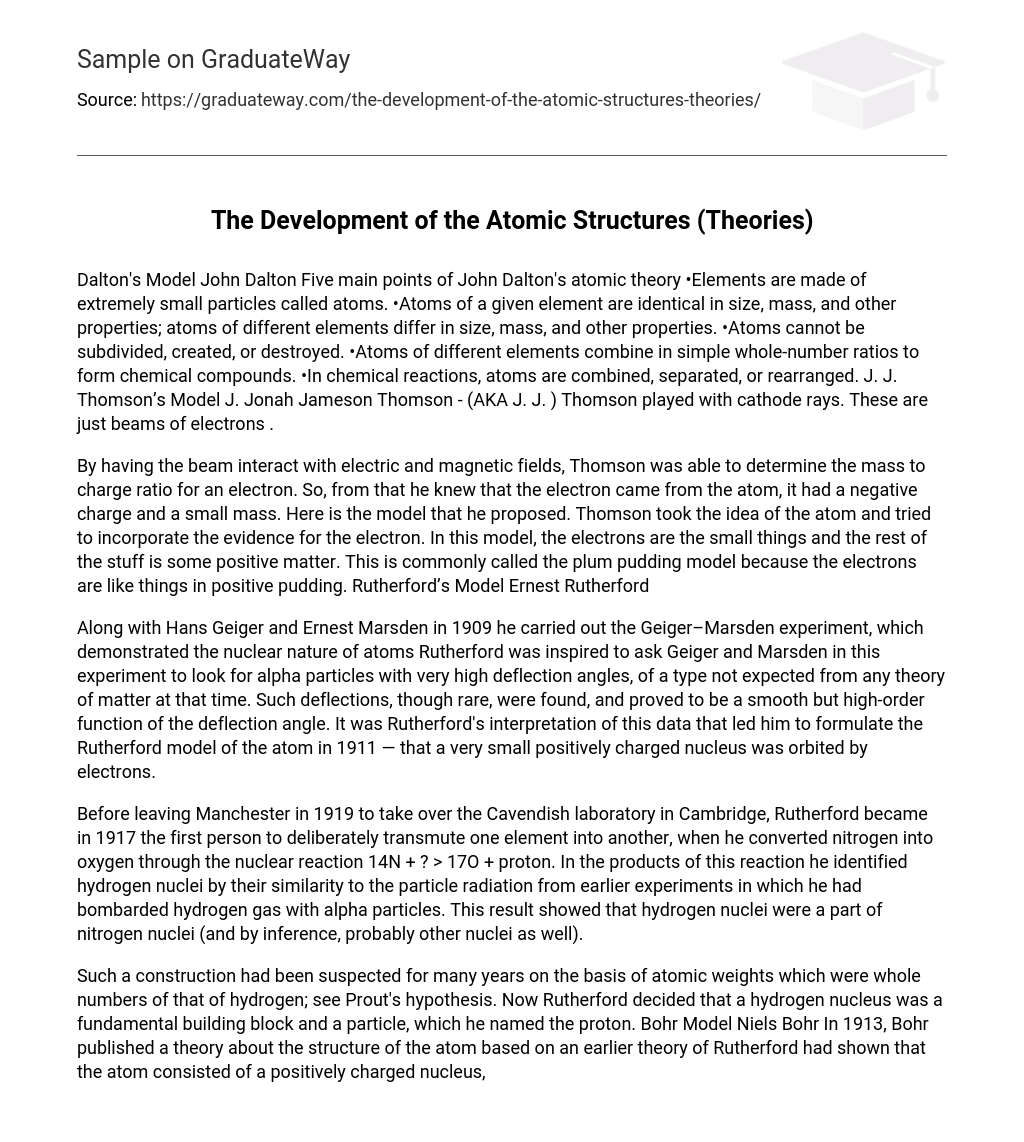Five main points of John Dalton’s atomic theory
- Elements are made of extremely small particles called atoms.
- Atoms of a given element are identical in size, mass, and other properties; atoms of different elements differ in size, mass, and other properties.
- Atoms cannot be subdivided, created, or destroyed.
- Atoms of different elements combine in simple whole-number ratios to form chemical compounds.
- In chemical reactions, atoms are combined, separated, or rearranged.
J. J. Thomson’s Model J. Jonah Jameson Thomson – (AKA J. J. ) Thomson played with cathode rays. These are just beams of electrons . By having the beam interact with electric and magnetic fields, Thomson was able to determine the mass to charge ratio for an electron. So, from that he knew that the electron came from the atom, it had a negative charge and a small mass. Here is the model that he proposed.
Thomson took the idea of the atom and tried to incorporate the evidence for the electron. In this model, the electrons are the small things and the rest of the stuff is some positive matter. This is commonly called the plum pudding model because the electrons are like things in positive pudding. Rutherford’s Model Ernest Rutherford
Along with Hans Geiger and Ernest Marsden in 1909 he carried out the Geiger–Marsden experiment, which demonstrated the nuclear nature of atoms Rutherford was inspired to ask Geiger and Marsden in this experiment to look for alpha particles with very high deflection angles, of a type not expected from any theory of matter at that time. Such deflections, though rare, were found, and proved to be a smooth but high-order function of the deflection angle. It was Rutherford’s interpretation of this data that led him to formulate the Rutherford model of the atom in 1911 — that a very small positively charged nucleus was orbited by electrons.
Before leaving Manchester in 1919 to take over the Cavendish laboratory in Cambridge, Rutherford became in 1917 the first person to deliberately transmute one element into another, when he converted nitrogen into oxygen through the nuclear reaction 14N + ? > 17O + proton. In the products of this reaction he identified hydrogen nuclei by their similarity to the particle radiation from earlier experiments in which he had bombarded hydrogen gas with alpha particles. This result showed that hydrogen nuclei were a part of nitrogen nuclei (and by inference, probably other nuclei as well).
Such a construction had been suspected for many years on the basis of atomic weights which were whole numbers of that of hydrogen; see Prout’s hypothesis. Now Rutherford decided that a hydrogen nucleus was a fundamental building block and a particle, which he named the proton. Bohr Model Niels Bohr In 1913, Bohr published a theory about the structure of the atom based on an earlier theory of Rutherford had shown that the atom consisted of a positively charged nucleus, with negatively charged electrons in orbit around it.
Bohr expanded upon this theory by proposing that electrons travel only in certain successively larger orbits. He suggested that the outer orbits could hold more electrons than the inner ones, and that these outer orbits determine the atom’s chemical properties. Niels Bohr mentioned:
- Electrons are small and negatively charged
- Protons are in the nucleus with is small compared to the size of the atom
- For a particular element, only certain frequencies (colors) of light are absorbed or emitted.
Chadwick’s model James Chadwick In 1932, Chadwick proved the existence of neutrons. This momentous discovery contributed to the successful controlled fissioning of Uranium-235, and eventually to the development of the atomic bomb. In 1932, Chadwick exposed various elements, such as hydrogen and nitrogen, to “beryllium radiation”, and by measuring the energies of the recoiling charged particles, he deduced that the radiation was actually composed of electrically neutral particles which could not be massless like the gamma ray, but instead were required to have a mass similar to that of a proton. Chadwick now claimed these particles as Rutherford’s neutrons. Chadwick discovered neutrons.





